Flight Manual: Bookmark J 35J Draken 5.12024-04-04
Navigation systems
FLI 35 system
The FLI 35 system is a spatial data processing/presentation system comprising the main gyro, the attitude and horizontal situation indicators, and a waypoint navigation system.
FLI 35 processes data from the gyro, sensors and monitors, and presents information to the pilot. The system automatically compensates for magnetic deviation and gyro drift.
Ten waypoints can be programmed by entering predefined waypoint codes using a numerical keypad. The flight computer will calculate course, distance and estimated fuel consumption to the currently selected waypoint and present it on a LED display.
FLI 35 Control unit
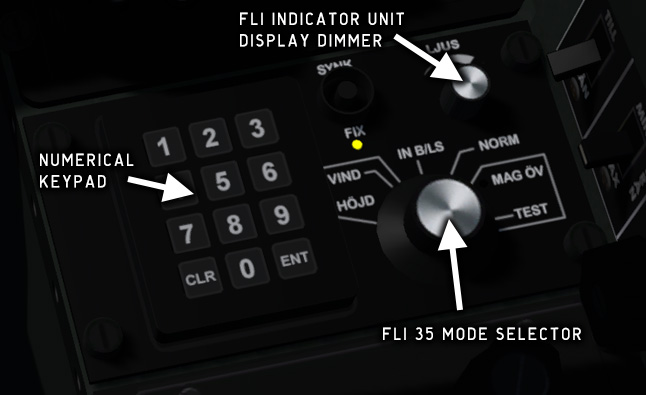
Fig. 50 - FLI 35 Control Unit
The Control Unit is used to select the FLI 35 operation mode and to program waypoints. The display on the Indicator Unit can be dimmed with the LJUS knob.
HÖJD
Not used in 35J - Indicator Unit will show FEL (error).
VIND
Used to enter predicted winds. Not functional in this simulation.
Indicator Unit will show ----.
IN B/LS
Programming mode - used when programming waypoints (see below).
NORM
Normal mode (default).
MAG ÖV
Backup mode - Indicator Unit is disabled.
The SYNK button and the FIX LED indicator are not functional in this simulation.
-
On the FLI 35 Control Unit, select IN B/LS to enter programming mode.
The Indicator Unit will alternately display waypoint slot number and waypoint code.
-
On the Indicator Unit, press B/LS repeatedly to select the desired waypoint slot (1 to 10).
-
On the Control Unit, press CLR to clear the selected waypoint.
-
Use the keypad to enter a waypoint code (e.g. 9010 for Ängelholm F10 AB).
See Appendix 4: PN-594 Nav stations for a list of waypoint codes.
-
Press ENT to store this waypoint in the current slot.
-
Press B/LS to select the next slot and repeat steps 3–5 as needed.
-
When finished, set the Mode Selector to NORM.
Programming FLI 35 waypoints
You can now use the keys on the Indicator Unit to cycle between waypoints and display the distance, bearing and predicted fuel consumption for each leg.
FLI 35 Indicator unit
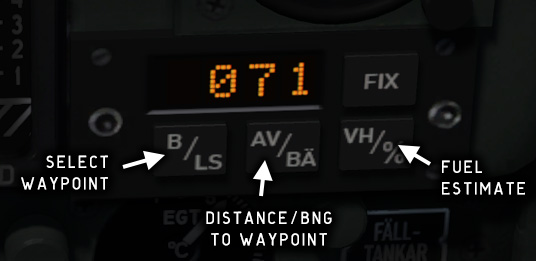
Fig. 51 - FLI 35 Indicator unit
B / LS
Press repeatedly to cycle through waypoints 1–10.
AV / BÄ
Calculated distance/bearing to the selected waypoint is shown alternatingly for 2 seconds.
Course is always shown with three digits (000–359).
VH / %
Estimated fuel consumption to the waypoint as a percentage of total fuel capacity (external tanks included).
FIX
Updates the selected waypoint with the current position.
The FIX key has no function in this version.
FLI 35 instruments
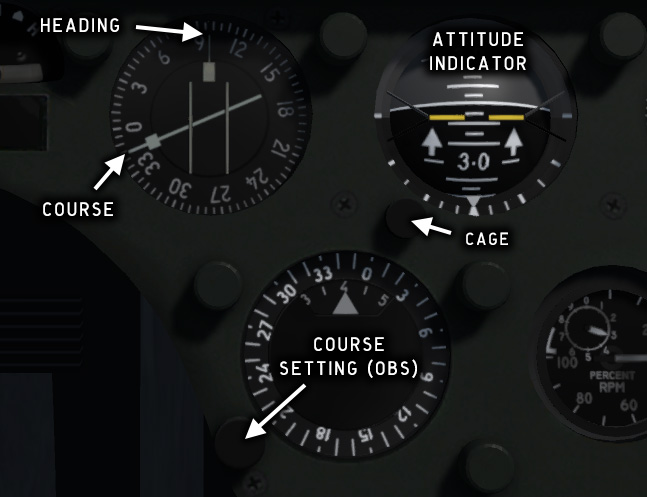
Fig. 52 - FLI 35 main instruments
Attitude indicator
The FLI 35 attitude indicator is electrical and is connected to the main gyro via the FLI 35 flight computer. In case of a FLI 35 system failure there is a backup attitude indicator which is connected to a separate gyro.
Course/Heading indicator
The course/heading indicator is basically a HSI without VOR indication. The rotating scale shows the magnetic heading. The course indicator needle can be commanded by the flight computer or set manually with the course selector.
The course/heading indicator is powered by the AC bus. The scale and needle will freeze when AC power is off.
Course selector
The course selector is used to manually set the course needle on the course/heading indicator. It basically corresponds to the OBS setting in VOR navigation.
PN-594/A system
J 35J did not have civilian VOR/ILS. Instead, it relied on a query/response signalling system between the aircraft and military ground stations for long-range navigation and landing guidance. The aircraft queried the ground station, and the response signals were processed by an on-board computer that controlled the crossbars in the radar scope.
This system was called PN-594/A, and the navigation and landing systems were respectively nicknamed Anita and Barbro. Draken 5.1 includes a special scenery with TACAN and ILS navaids that simulate the Anita and Barbro stations.
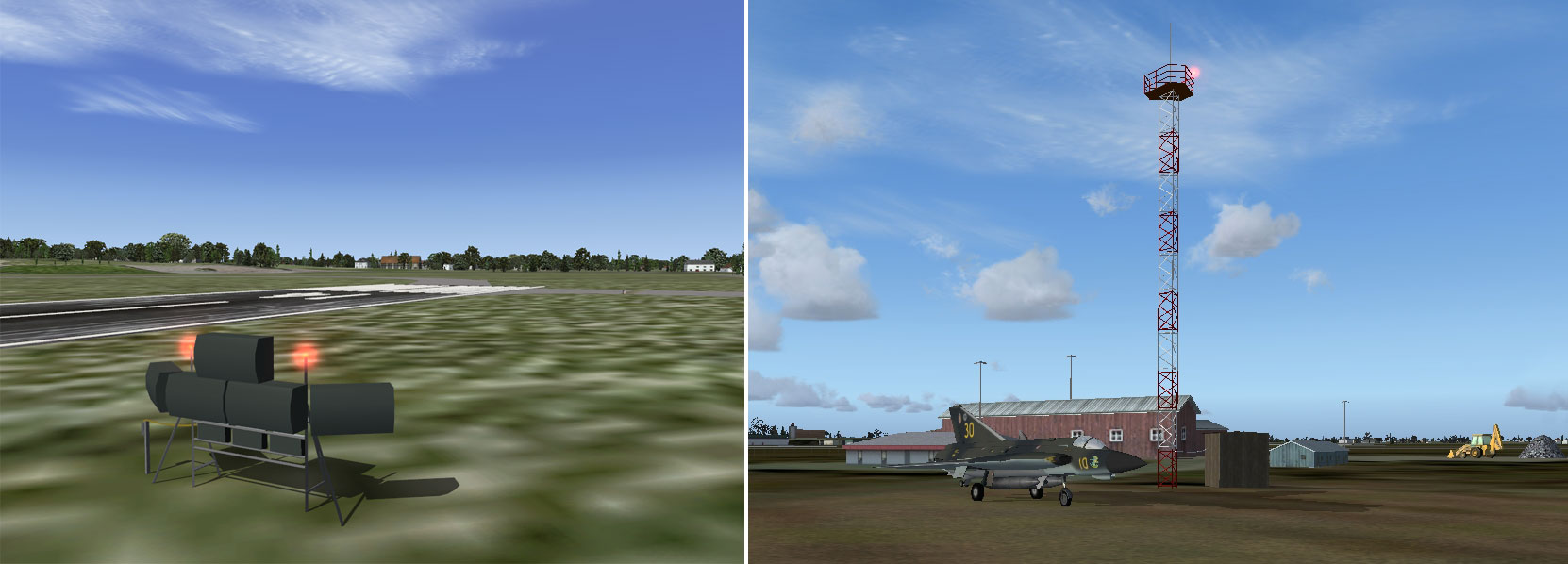
Fig. 53 - Barbro and Anita scenery objects
The Anita station basically works as a long-range DME. The maximum range is 400 km (216 NM), although the actual range depends on altitude and terrain.
The Barbro station is located slightly offset from the runway. The approach path deviates from the centerline by a few degrees and intersects it at a point 800 m out from the touch-down point. The glide path is 2.86°. The maximum range of the Barbro station is 30 km (16 NM).
To fly an approach, set the desired Barbro station on the LANDN dial of the PN-594 unit and select LANDN40, then keep the vertical crossbar centered. You will be guided in an optimal turn to a point intersecting the centerline. To capture the signal you need to be within a 72° sector of the approach and within range of the Barbro station.
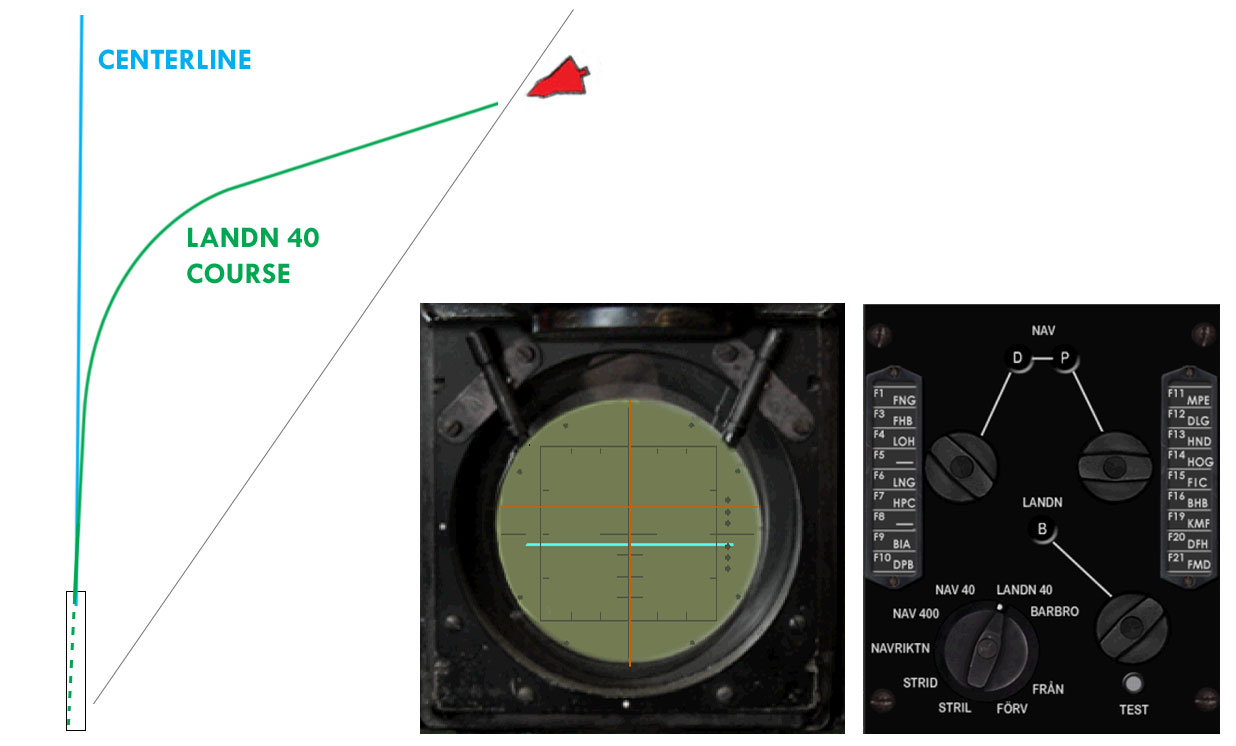
Fig. 54 - Flying a LANDN 40 approach
PN-594 Control Panel
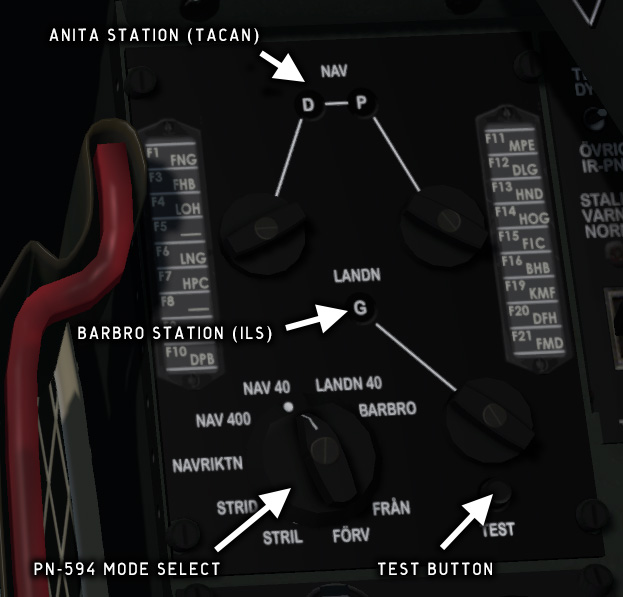
Fig. 55 - PN-594 control panel
The NAV dials are used in combination to select the two-letter ANITA station code.
The LANDN dial selects the BARBRO station.
See Appendix 4: PN-594 Nav stations for a list of ANITA/BARBRO codes.
| Mode | DME scale | Vertical FD bar | Horiz FD bar |
|---|---|---|---|
|
FRÅN |
Off |
Off |
Off |
|
FÖRV |
Off |
Off |
Off |
|
STRIL |
Off |
STRIL commanded course (here: FLI 35 waypoints) |
Off |
|
STRID |
Off |
Off |
Off |
|
NAVRIKTN |
Off |
ANITA/VOR |
Off |
|
NAV 400 |
400 km |
ANITA/VOR |
Off |
|
NAV 40 |
40 km |
ANITA/VOR |
Off |
|
LANDN 40 |
40 km |
BARBRO/LLZ intercept |
BARBRO/ILS glide slope |
|
BARBRO |
40 km |
BARBRO/LLZ deviation |
Off |
Test button
To test the crossbars, select NAVRIKTN and push the TEST button on the PN-594 control panel. The vertical crossbar should now move to the center.
Flight director
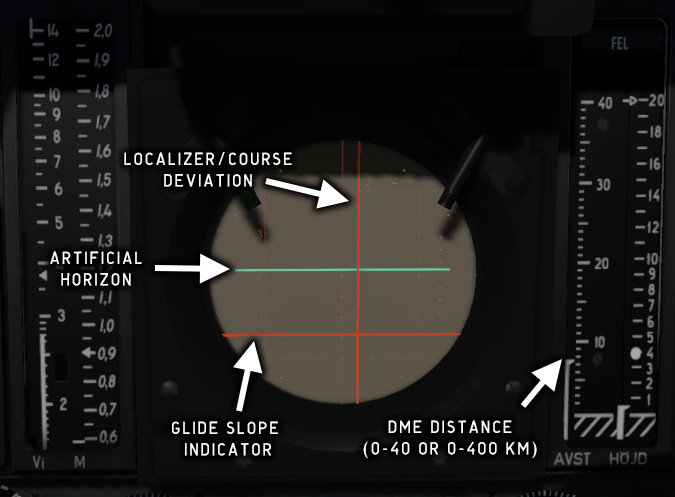
Fig. 56 - Flight director crossbars
The horizontal bar is a glide slope indicator for Barbro stations in LANDN40 mode and for ILS in manual mode.
The vertical bar works like a standard LLZ indicator for Barbro stations in BARBRO mode and for VOR/ILS in manual mode. In LANDN40 mode it will guide you into an optimal turn until you are exactly on the localizer course.
The crossbar illumination brightness is controlled with the KORSVISARE dimmer on the weapons control panel.
In LANDN40 and BARBRO modes the distance indicator shows distance to the TDZ of the selected runway. In all other modes it shows distance to the DME transmitter.
Manual tuning unit
To enable standard VOR/ILS navigation in Prepar3D a fictional VHF tuning unit has been included here. This unit is similar to the Collins VHF radio tuners that were used in earlier versions of Draken and in some export versions. It was not present in the real J 35J.
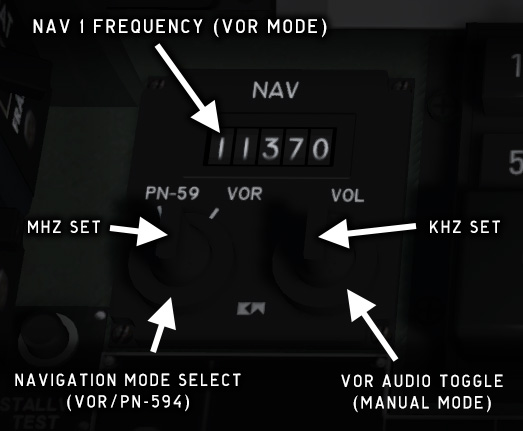
Fig. 57 - Navigation radio selector / manual tuning unit
-
The knobs are used to set VOR/ILS frequency (use the scrollwheel).
-
The left ring is used to toggle between VOR and PN-59 navigation.
-
The right ring (VOL) is used to toggle VOR audio on/off.
Copyright © 2001–2024 Bookmark AB